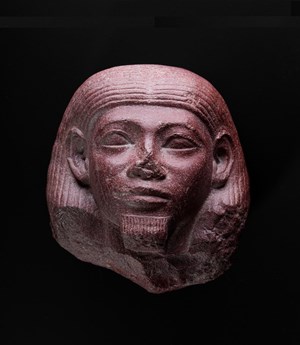
The story of the remarkable discovery of a group of Egyptian objects uncovered at Melville House in Fife between 1952 and 1984 is being told in full for the first time in an article published in the upcoming Proceedings of the Society of Antiquaries of Scotland.
The 18 objects - including a statue head described by curators as a ‘masterpiece of Egyptian sculpture’ - were discovered on three separate occasions, and most are now in National Museums Scotland’s collection. They are the only ancient Egyptian objects to be formally declared Treasure Trove in Scotland. The article, by Dr Elizabeth Goring and Dr Margaret Maitland, examines how these events unfolded and the attempts made to establish how the objects ended up buried at Melville House.
In 1984, Dr Goring was a new curator at the then Royal Scottish Museum (now the National Museum of Scotland) when a group of teenage boys brought in an object to be identified. The boys were from a residential school run by the then Fife Regional Council, and the object – an Egyptian bronze figurine of a man - had been found in the school grounds by a boy using a metal detector.
The school was based in Melville House, near Monimail, a fine stately home commissioned by the first Earl of Melville in 1697. Upon consultation with colleagues, Dr Goring learned that Egyptian objects had turned up in the grounds of this house on two previous occasions.
In 1952, Melville House was occupied by the private Dalhousie Castle School. That year, a boy was digging up potatoes as part of a punishment exercise and uncovered a fine mid-12th Dynasty red sandstone statue head, which he initially mistook for a potato. It was brought to the Museum and subsequently acquired for the collection.
In 1966, an Egyptian bronze votive statuette of an Apis bull was found in the grounds when a boy taking part in a vaulting exercise during a PE class landed on the statuette, which was protruding from the earth. The supervising teacher, who happened to be the very boy who had found the sandstone head in 1952, brought the object into the Museum for identification.
It was clear that the three objects were connected, and that there had once been a collection associated with Melville House. Dr Goring arranged to investigate the site, and subsequently discovered a number of other objects, ranging from the top part of a fine faience figurine of the goddess Isis suckling her son Horus to part of a faience plaque bearing the Eye of Horus.
Following the excavation, research was carried out to establish the original ownership of the objects in the UK. As nothing conclusive could be proven, the finds were treated as Treasure Trove and allocated to the Royal Scottish Museum. Visitors to the National Museum of Scotland today can view the magnificent statue head in the Ancient Egypt Rediscovered gallery.
Dr Elizabeth Goring said:
“Excavating and researching these finds at Melville House has been the most unusual project in my archaeological career, and I’m delighted to now be telling the story in full. Uncovering ancient Egyptian objects in Fife is clearly unexpected, and the subsequent research to establish the origins of the collection has provided a fascinating tale, albeit one with further mysteries which may never be solved.”
One possible explanation of how these objects ended up buried at Melville House is that they were acquired by Alexander, Lord Balgonie (1831-1857) the heir to the property who visited Egypt in 1856 with his two sisters to try to improve his poor health, after falling ill during service in the Crimean War.
During this period in Egypt, consuls and dealers would visit hotels or passing boats to sell antiquities, so it is possible the objects were brought to a bedridden Balgonie or that his sisters assembled the collection.
Upon return to the UK, they may have been kept for a time at Melville House before being consigned to an outbuilding. It’s possible that they were either forgotten in the immediate grief of the young Balgonie’s death or abandoned as too painful a memory of the trip. Eventually, the outbuilding in which they had been deposited was demolished and those long-forgotten objects went unnoticed in the building debris.
Dr Margaret Maitland, Principal Curator of the Ancient Mediterranean at National Museums Scotland said:
“This is a fascinating collection, made all the more so by the mystery surrounding its origins in this country. The discovery of Egyptian artefacts that had been buried in Scotland for over a hundred years is evidence of the scale of 19th century antiquities collecting and its complex history. It was an exciting challenge to research and identify such a diverse range of artefacts, including some remarkable objects - the bronze priest statuette is a relatively rare form, while the sandstone statue head is a masterpiece of Egyptian sculpture.”
Dr Simon Gilmour, Director of the Society of Antiquaries of Scotland, said:
"We're thrilled to publish this extraordinary paper in our annual journal. Since 1851, the Proceedings has shared high quality, cutting-edge research into Scotland’s history and archaeology; over 170 years on, we welcome submissions from anyone wanting to share new stories about Scotland’s past.”
Main Image :Head of a statue of a man in sandstone, mid-12th Dynasty (about 1922-1874 BC) Photo: © National Museums Scotland.

ArtDependence Magazine is an international magazine covering all spheres of contemporary art, as well as modern and classical art.
ArtDependence features the latest art news, highlighting interviews with today’s most influential artists, galleries, curators, collectors, fair directors and individuals at the axis of the arts.
The magazine also covers series of articles and reviews on critical art events, new publications and other foremost happenings in the art world.
If you would like to submit events or editorial content to ArtDependence Magazine, please feel free to reach the magazine via the contact page.